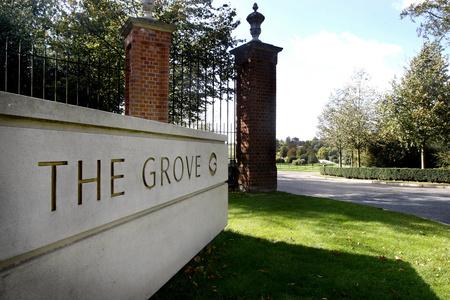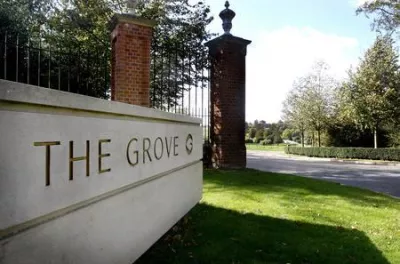
The Grove Entrance


The Grove Entrance
Today, The Grove is a luxury hotel and spa, where you can escape the pressures of everyday life with a massage or a spot of golf. However, the history of The Grove goes back many centuries, and it’s full of tales of ghosts and lavish royal parties.
The first substantial house was built at The Grove during the reign of Queen Elizabeth I, although archaeologists have unearthed some Bronze Age pottery on this site, pointing to our ancestors settling there as early as 7,000 BCE.
In the early eighteenth century Viscount Doneraile, an Anglo-Irish peer, owned the estate, and his building work on the house included rebuilding an ancient chapel into a kitchen. Legend has it that Lord Doneraile, as punishment for this, is condemned to spend the next life pursuing a ghostly fox through the grounds on horseback, accompanied by a pack of phantom hounds. Many workmen have claimed to have witnessed this event, and details appeared in the Watford Observer in March, 1974, having been relayed by a staff member at The Grove.
In 1776 the house was bought and developed by the first Earl of Clarendon (Second Creation), Thomas Villiers, a Lord Commissioner of the Admiralty, one of only seven members of the Board of Admiralty, exercising control over the Royal Navy at a time when it was becoming the most powerful navy, as well as one of the biggest industrial complexes, in the world.
In about 1778 Captain Cook presented Lord Clarendon with a sapling of the just-discovered Black Walnut tree. This impressive tree still stands today, towering over the Terrace of the Grove.
The Earl of Clarendon and his neighbour, the Earl of Essex, found in 1794 that the best route for the Grand Junction Canal took the canal down the river Gade and through the parks, The Grove and Cassiobury, of both of them. Initially they were to be by-passed through an expensive tunnel under Langleybury, but their Lordships were persuaded to allow the waterway to follow the obvious path. Lord Essex was a member of the Committee of the Grand Junction Company, so had much influence: the two earls took some encouraging (and paying), but eventually the canal was allowed to follow the Gade, as it still does, although an elaborate bridge was and still is required to carry the Grove carriageway over the canal.
In the 1830s, the London & Birmingham Railway wanted to build new tracks along the same course of the Gade Valley across The Grove estate. The third Earl, John Villiers, however, would not tolerate it, and the railway company had to seek an alternative course, resulting in the lengthy and expensive Watford tunnels.
The third Earl had been a significant figure, including being a Privy Councillor and Comptroller of the King’s Household, but he retired from public life after succeeding his brother as Earl in 1824, devoting himself instead to religious and charitable activities.
George Villiers, fourth Earl of Clarendon, was appointed minister (ambassador) at the court of Spain. Slavery had been illegal in the Spanish colonies from 1820, but many ignored this and continued to keep slaves. George worked with the help of Times correspondent David Turnball to remove slavery from Spanish colonies. He received the Grand Cross of the Bath in acknowledgement of his services, and was later made a Knight of the Garter.
In 1846, the fifth Earl became Queen Victoria’s secretary and aide, and started the English tradition of lavish house parties for the Queen and her entourage. House guests at The Grove during this time included the Prince of Wales (later Edward VII), Lord Palmerston and many other prominent people: invitations were highly sought after and prized, with guests driving down from London on Saturday and returning on Monday. It was a new phenomenon which The Times named “Weekending”.
In the early 20th century death duties (a tax introduced in 1894) were placing an increasing financial burden on landowners and were responsible for the breaking up of many large estates across Britain. In the 1920s, in order to reduce their tax liabilities, the Villiers family decided to sell The Grove, The Times publishing a letter mourning the passing of “one of the greatest political houses of the 19th century”. The Grove was then was used as a gardening school, then a health centre, a riding school and a girls' boarding school. It was the 'secret' wartime headquarters of the London Midland and Scottish Railway, and so of strategic importance: it was called simply ‘Project X’, and the Local Defence Volunteers, to become a little later the Home Guard, patrolled the Grove and surrounding roads from dusk till dawn. After Dunkirk, when an attack seemed most likely, they began patrolling with loaded rifles.
Six air raid shelters from this period can still be seen in the grounds today, and are now home to one of England’s largest colonies of Pipistrelle bats.
After railway nationalisation The Grove became the management training centre for the British Transport Commission and then for British Rail. But by 1996 the Grove was in a ruinous state: it was rescued by Ralph Trustees Limited, and it opened eight years later as a luxury hotel and spa, which it now is.
Information courtesy of Chris Reynolds of www.hertfordshire-genealogy.co.uk
Based on an article from the Watford Observer Nostalgia Series by Kelly Pells, reproduced courtesy of The Watford Observer